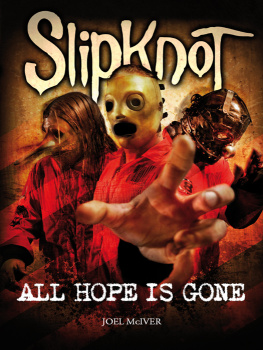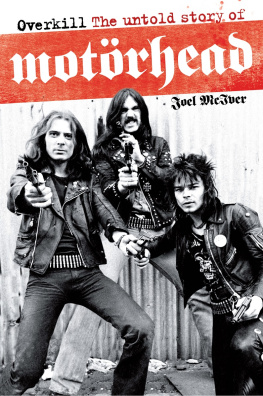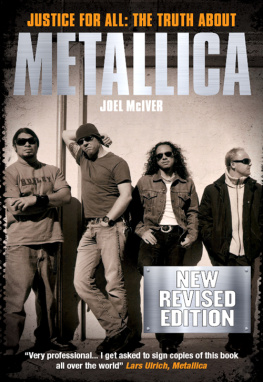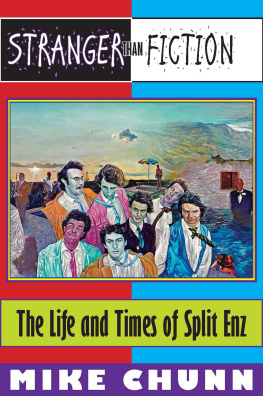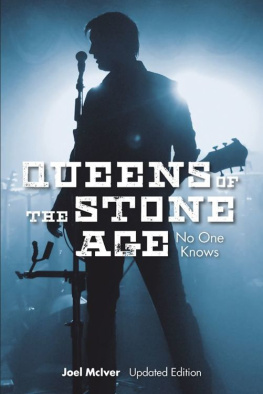Copyright 2012 Omnibus Press
This edition 2012 Omnibus Press
(A Division of Music Sales Limited, 14-15 Berners Street, London W1T 3LJ)
EISBN: 978-0-85712-772-3
Cover designed by Fresh Lemon
Picture research by Jacqui Black
The Author hereby asserts his / her right to be identified as the author of this work in accordance with Sections 77 to 78 of the Copyright, Designs and Patents Act 1988.
All rights reserved. No part of this book may be reproduced in any form or by any electronic or mechanical means, including information storage and retrieval systems, without permission in writing from the publisher, except by a reviewer who may quote brief passages.
Every effort has been made to trace the copyright holders of the photographs in this book, but one or two were unreachable. We would be grateful if the photographers concerned would contact us.
A catalogue record of this book is available from the British Library.
For all your musical needs including instruments, sheet music and accessories, visit www.musicroom.com
For on-demand sheet music straight to your home printer, visit www.sheetmusicdirect.com
Contents
Introduction
T he first edition of this book was published in 2001, when Slipknot were new to the public eye and received endless criticism for their outlandish overalls and masks, their sonic allegiance to the nu-metal movement which was waning fast at the time and their emotional frankness in interviews. Since then the world has turned a few times and the band have transcended all that, rising out of their niche and becoming one of the biggest metal acts in the world. This updated edition adds an account of those intervening years, although the focus is still where it should be on their early days, which most people still dont know about.
I was a different writer back then and tended to get a bit overexcited about things. My editor Chris Charlesworth removed much of the most self-indulgent prose, thank God, and Ive now toned it down a bit more, but no doubt youll find some of the text that follows a bit giddy.
Joel McIver, 2011
Acknowledgements
F or their help with the original 2001 edition: Kyle Munson, music critic with the Des Moines Register (all material reproduced from the Register is done so with the publishers permission); the late Mike Lawyer, the owner of SR Audio; producer Sean McMahon; sometime Slipknot members Anders Colsefni and Josh Brainard; Michelle Kerr at Roadrunner; Kas Mercer at Mercenary PR; Edward Axon at John Brown Publishing for his permission to reproduce material from Viz; Adrian Pertout.
Also: Emma, Alice, Tom, Robin and Kate, Dad, John and Jen, Naomi Alderman, David Barraclough, Scott Bartlett, Jacqui Black, Chas Chandler, Chris Charlesworth, Ben Cooper, Helen Donlon, John Doran, Jason Draper, Mark Eglinton, David Ellefson, Matthew Hamilton, Charlie Harris, Matt Higham, Bill Irwin, Talita Jenman, Patrizia Mazzuocolo, Alex Milas, Eugenio Monti, Bob Nalbandian, Martin Popoff, Jonathan Selzer, Kirsten Sprinks, Thomson Wall, Nick Wells and the families Bhardwaj, Bowles, Cadette, Edwards, Ellis, Freed, Harrington, Hogben, Knight, Lamont, Legerton, Mathieson-Spires, Maynard, Mendona, Miles, Parr, Sendall and Woollard plus the many visitors to www.joelmciver.co.uk and www.facebook.com/joelmciver.
Chapter 1
Before 1995
N othing really happens in Des Moines, Iowa. Its a conservative place and everything is pretty much straight and above board. Life-changing events in the musical field, at any rate dont come along very often, but when they do they make a hell of an impact. An infamous example was the banning of CW McCalls 1976 Convoy single by a Des Moines radio station. The reason? Because the song supposedly incited truck drivers to break speed limits. As an illumination of the cultural stance of the citys establishment, this will do nicely. But worse was to come.
In late 1982, Des Moines was scheduled for a visit by one of the godfathers of heavy metal, Ozzy Osbourne, sometime singer with the British metal behemoths Black Sabbath and a hell-raiser of mythical fame. The show was notable for an incident that occurred towards the end of the set. It was common for fans to throw various items on stage during Ozzys shows in response to the general anarchy of his act. Often Ozzy found himself dodging raw meat but on this occasion, an unidentified member of the audience threw a live bat onto the stage. The species and overall condition of the unfortunate mammal is not recorded; however, it was clearly traumatised enough to lie still and, perhaps unsurprisingly, the singer assumed that it was made of rubber.
To the shock of the crowd, Ozzy picked it up and bit off its head. Although he realised his error instants later and spat out the offending mouthful, he was rushed immediately to the nearest hospital, where he had his stomach pumped and endured a series of precautionary anti-rabies injections. These are legendarily agonising, as the needle has to pass through the abdominal muscles in order to penetrate the stomach. Ozzy ruefully said in later interviews that hed learned his lesson no doubt a relief to pipistrelles everywhere and continued his tour after a short recovery period. The incident only heightened his profile as a genuine metal nutter, and his profile has continued to rise ever since.
The effect of this show on the metal fans of Des Moines was electrifying. Among those who werent at the show, but wished he could have been when he came across radio and newspaper reports of the bats untimely demise, was a 12-year-old schoolkid by the name of Shawn Crahan. Born in September 1969 to real estate developers, Crahan was obsessed with exploring the citys storm drains dark, undisturbed tunnels big enough for an adult to walk through and playing the drums. His earliest musical heroes were Kiss: the very first album he had ever bought was Dynasty, and it was Peter Criss who first inspired him to become a drummer. When asked in 1999 by the Seattlesquare webzine what the future members of Slipknot were like as children, Shawn said, Id say we were all hyperactive, and depressed, and just always in trouble you know, just doing our thing. I think we were all nutty little kids, and I think maybe some of us were really quiet and just looking out from the inside.
By the time he was 15, Shawn had honed his drumming skills enough to form a band at Des Moines Hoover High School, which he named Heads On The Wall. The line-up included an Asian teenager named Kun Nong an excellent guitarist by all accounts and a bass player named Doug, who also handled vocals. Proficient by high-school standards, the band exceeded most teenage groups ambitions by playing at venues all over Iowa. Musically, their funk-metal and thrash-metal influences were clear; their sets included eighties hits by the Red Hot Chili Peppers (whose early albums possessed a grittier edge than their later, more polished work) and went as far as covering songs by alternative acts such as Primus and Janes Addiction. Ultimately, however, they were limited by the fact that Kun Nongs sympathies were far more inclined towards funk and soul and after all, Heads On The Wall were still at school. As Crahan realised that the future for his band was limited, he began to look around for something more serious.
Another successful local band was the death metal act Vexx, who later went under the name of Inveigh Catharsis. The drummer was the thick-set Anders Colsefni, an intimidating figure with a Mohican haircut. Colsefni had developed an uncompromising percussion technique, which became a high point of Vexx shows. The bassist was Paul Gray, a superb player who had mastered the guitar before moving onto bass: originally from Los Angeles, Gray had recently wound up in Des Moines and perhaps wanting to recapture the positive, do-it-all vibe of California had thrown himself into the band with gusto. On guitar was Josh Brainard, another accomplished musician who was initially from New Mexico but had moved several times before his teens, finally ending up in Des Moines after a move from the nearby town of Waterloo.

